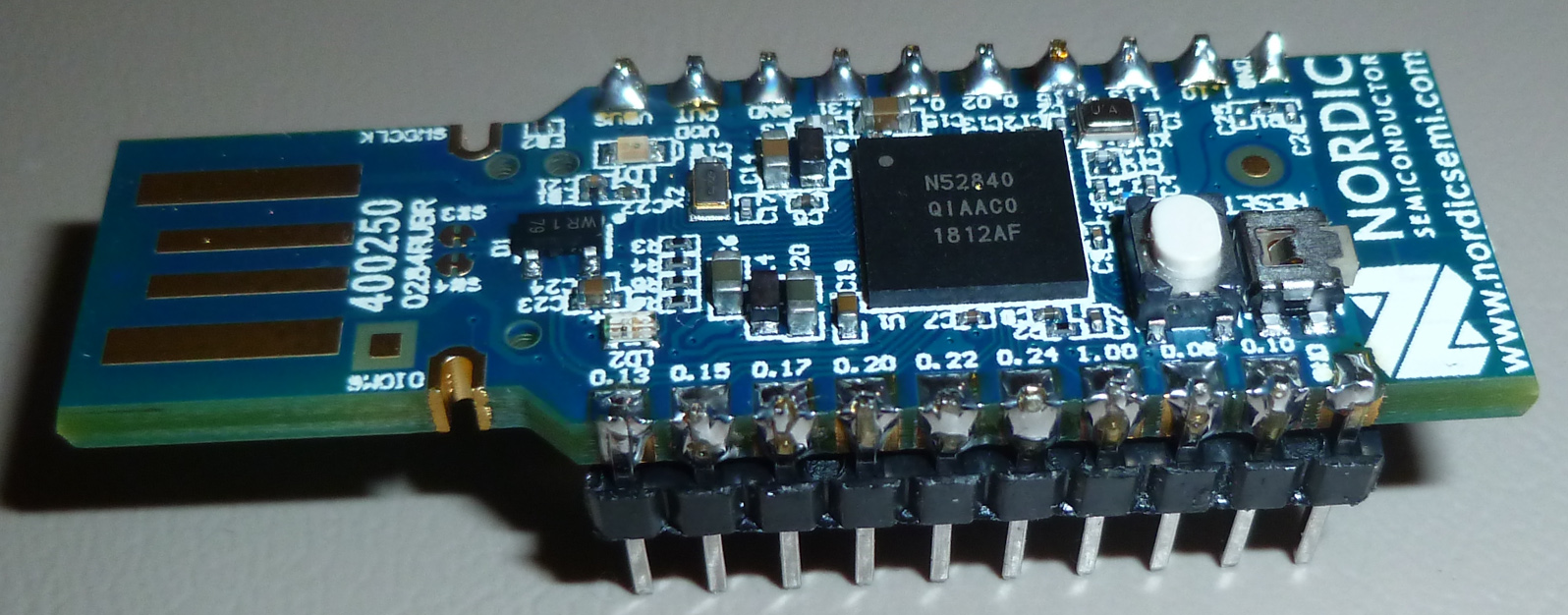Everything nRF52840
-
I did an nRF52840 drop-in upgrade to the BT840F module and was able to program it to transmit. It works!
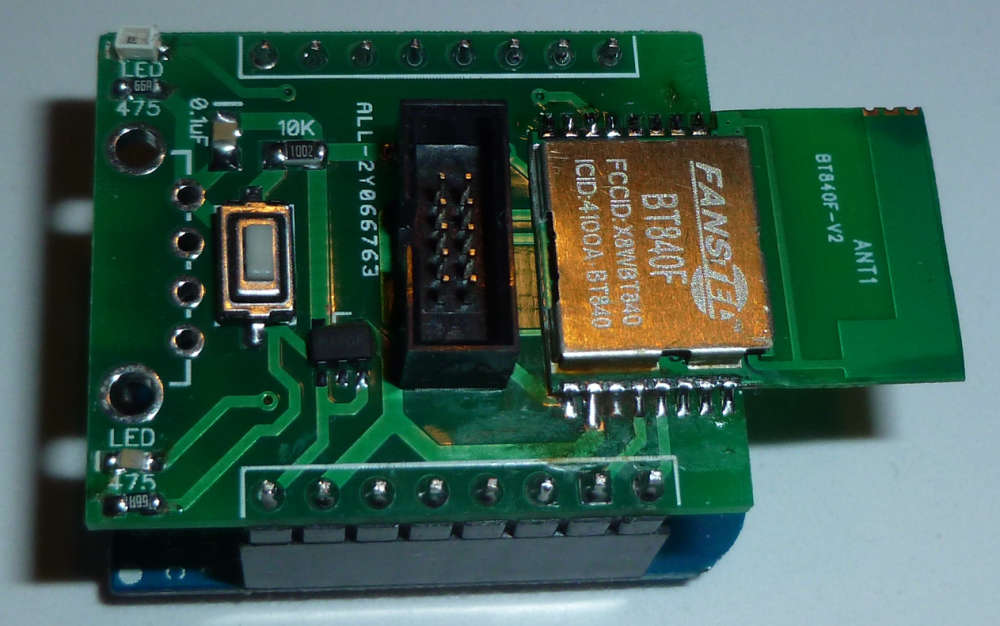
-
Here's a size comparison of the nRF52840 BT840F to the BT832X (an amplified nRF52832).
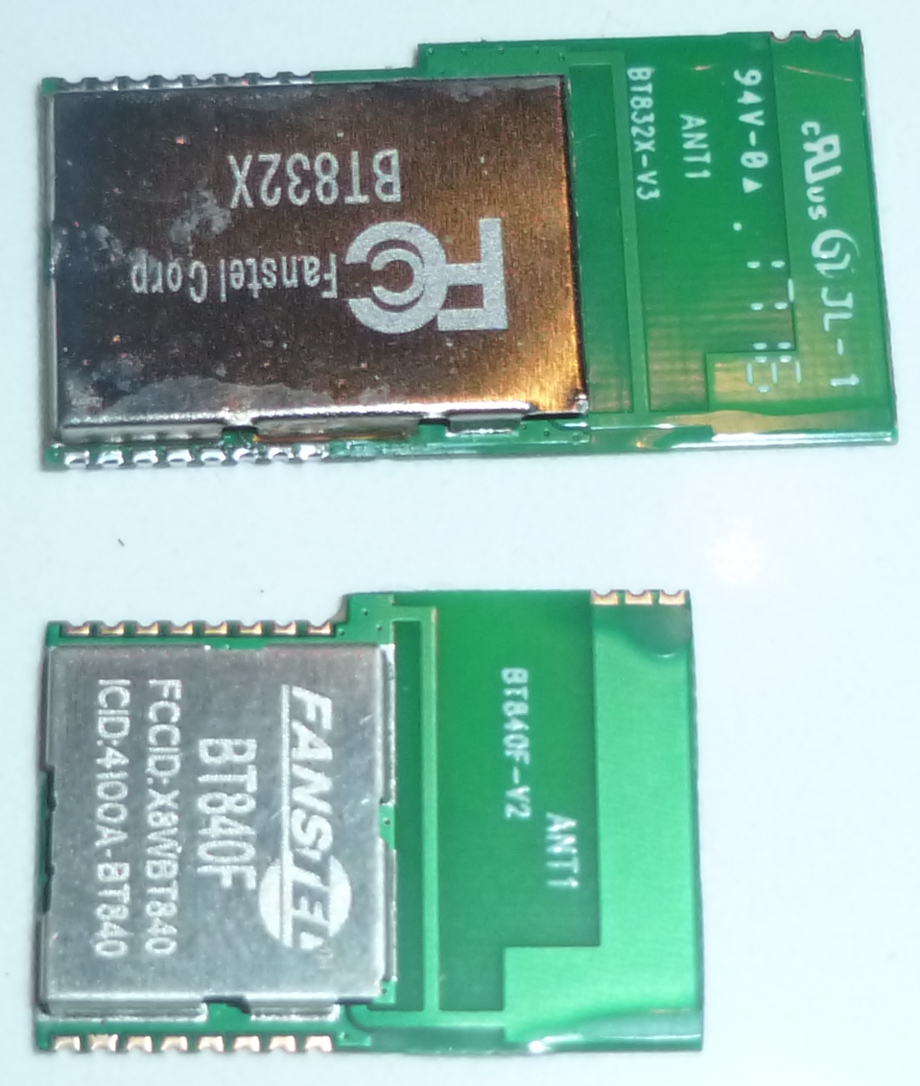
I'm not aware of any amplified nRF52840 modules, but I would, of course, be interested if there are any.
-
It appears that at present the mbed compiler doesn't yet recognize the P1.xx pins of the nRF52840, but only the P0.xx pins. Not good! I'll try to find out whether mbed intends to fix that or not.
-
Could you explain a bit what's so cool about this new chip?
Does it work as a USB stick that you just place a .hex file on to program it? Like the Micro:bit?
Can you run it, as well as some connected sensors, just by plugging it into a usb charger? Like a Arduino Nano? -
Could you explain a bit what's so cool about this new chip?
Does it work as a USB stick that you just place a .hex file on to program it? Like the Micro:bit?
Can you run it, as well as some connected sensors, just by plugging it into a usb charger? Like a Arduino Nano?@alowhum yes to all the questions.
You don't have to use usb, but it's built into the nRF52840 chip if you want to use it.
As far as what's cool about it, well, that's a long list. Read the 1 page summary on page 1 of the datasheet. It packs a lot of punch into a small space and yet it's relatively low power.
-
Here's some simple code for transmitting a 1 byte payload at 2mbps once every second:
//This program sends a one byte payload in a packet once every second. #include "mbed.h" uint8_t txBuffer[200]; //buffer required for transmitting a payload. uint8_t targetAddress[] = {0xAA, 0xDE, 0xAD, 0xBE, 0xEF}; Serial pc(USBTX, USBRX); // tx, rx void initializeSerialOutput() { pc.baud (9600); pc.printf("Starting...\n"); } void initializeHardware () { NRF_POWER->DCDCEN=1; //enable the DCDC voltage regulator } void initializeClocks () { NRF_CLOCK->TASKS_HFCLKSTART=1; //activate the high frequency crystal oscillator while (NRF_CLOCK->EVENTS_HFCLKSTARTED==0) {}; //wait until high frequency clock start is confirmed } void initializeRadio () { //No need to set the preamble. For Nordic's proprietary radio modes, the preamble (either 0xAA or 0x55) is 1 byte long and is chosen by the hardware. uint32_t theTargetBaseAddress; theTargetBaseAddress=(((uint32_t)targetAddress[1])<<24)|(((uint32_t)targetAddress[2])<<16)|(((uint32_t)targetAddress[3])<<8)|((uint32_t)targetAddress[4]); //target base address pc.printf("The target address is 0x%X%lX\n",targetAddress[0],theTargetBaseAddress); NRF_RADIO->BASE0=theTargetBaseAddress; //target base address NRF_RADIO->PREFIX0=targetAddress[0]; //target prefix address NRF_RADIO->FREQUENCY=98; //2498Mhz. value must be between 0 and 100 NRF_RADIO->PCNF1 = 0x40101; //Means: base address is 4 bytes long (possible range is 2 to 4) and max size of payload is 1,and 1 bytes of static length payload NRF_RADIO->PCNF0=0; //S0,LENGTH, and S1 are all zero bits long. NRF_RADIO->MODE=1; //set 2Mbps datarate. NRF_RADIO->MODECNF0=1; //enable fast ramp-up of radio from DISABLED state. NRF_RADIO->CRCCNF=3; // CRC will be 3 bytes and is computed including the address field NRF_RADIO->PACKETPTR=(uint32_t)txBuffer; //pointer to the payload in txBuffer NRF_RADIO->RXADDRESSES=1; //receive on logical address 0. Not important for transmitting. NRF_RADIO->TXPOWER=8; //set to 8db transmit power, which is the maximum. NRF_RADIO->TASKS_DISABLE=1; //DISABLE the radio to establish a known state. while (NRF_RADIO->STATE) {}; //wait until radio is DISABLED (i.e. STATE=0); NRF_RADIO->TASKS_TXEN=1; //turn on the radio transmitter and shift into TXIDLE. while (!(NRF_RADIO->EVENTS_READY)) {} //Busy-wait. After event READY, radio shall be in state TXIDLE. NRF_RADIO->TASKS_START=1; //Move from TXIDLE mode into TX mode. } int main() { initializeSerialOutput(); initializeHardware(); initializeClocks(); initializeRadio(); while (true) { if (NRF_RADIO->STATE!=11) { //if radio no longer in TX state, then it must have sent a packet wait_ms(1000); //wait one second before sending next packet txBuffer[0]++; //increment the payload value to send something different NRF_RADIO->TASKS_START=1; //Move from TXIDLE mode into TX mode to transmit another packet } } } -
Here is the corresponding simple code for receiving each packet from the transmitter code above:
//This program receives packets with a one byte payload. #include "mbed.h" uint8_t rxBuffer[200]; //required buffer for receiving packet uint8_t myAddress[] = {0xAA, 0xDE, 0xAD, 0xBE, 0xEF}; Serial pc(USBTX, USBRX); // tx, rx void initializeSerialOutput() { pc.baud (9600); pc.printf("\n\nStarting...\n"); } void initializeHardware () { NRF_POWER->DCDCEN=1; //enable the DCDC voltage regulator as the default. } void initializeClocks () { NRF_CLOCK->TASKS_HFCLKSTART=1; //activate the high frequency crystal oscillator while (NRF_CLOCK->EVENTS_HFCLKSTARTED==0) {}; //wait until high frequency clock start is confirmed } void initializeRadio () { //No need to set the preamble. For Nordic's proprietary radio modes, the preamble (either 0xAA or 0x55) is 1 byte long and is chosen by the hardware. uint32_t myBaseAddress; myBaseAddress=(((uint32_t)myAddress[1])<<24)|(((uint32_t)myAddress[2])<<16)|(((uint32_t)myAddress[3])<<8)|((uint32_t)myAddress[4]); //target base address pc.printf("My address is 0x%X%lX\n",myAddress[0],myBaseAddress); NRF_RADIO->BASE0=myBaseAddress; //target base address NRF_RADIO->PREFIX0=myAddress[0]; //target prefix address NRF_RADIO->FREQUENCY=98; //2498Mhz. value must be between 0 and 100 NRF_RADIO->PCNF1 = 0x40101; //Means: base address is 4 bytes long (possible range is 2 to 4) and max size of payload is 1,and 1 bytes of static length payload NRF_RADIO->PCNF0=0; //S0,LENGTH, and S1 are all zero bits long. NRF_RADIO->MODE=1; //set 2Mbps datarate. NRF_RADIO->MODECNF0=1; //enable fast ramp-up of radio from DISABLED state. NRF_RADIO->CRCCNF=3; // CRC is is 3 bytes and is computed including the address field NRF_RADIO->PACKETPTR=(uint32_t)rxBuffer; //put the received payload in rxBuffer NRF_RADIO->RXADDRESSES=1; //receive on logical address 0 NRF_RADIO->TASKS_DISABLE=1; //sleep the radio while (NRF_RADIO->STATE) {}; //wait until radio is DISABLED (i.e. STATE=0); NRF_RADIO->TASKS_RXEN=1; //turn on the radio receiver and enter into state RXIDLE while (!(NRF_RADIO->EVENTS_READY)) {} //Busy-wait. After event READY, radio shall be in state RXIDLE. NRF_RADIO->TASKS_START=1; //Move from RXIDLE mode into RX mode. } int main() { initializeSerialOutput(); initializeHardware(); initializeClocks(); initializeRadio(); while (true) { if (NRF_RADIO->STATE!=3) {// if radio no longer in RX state, it must have received a packet. pc.printf("Payload Received! Payload=%d\n",rxBuffer[0]); NRF_RADIO->TASKS_START=1; //Move from RXIDLE mode into RX mode so as to receive the next packet } } }These two example demo codes should be enough to get anyone started on using the nRF52840. :)
Indeed, it relies very little on mbed (just the printf's and the wait function), so you could easily move it to a different tool chain if you wanted to.
-
Here is the corresponding simple code for receiving each packet from the transmitter code above:
//This program receives packets with a one byte payload. #include "mbed.h" uint8_t rxBuffer[200]; //required buffer for receiving packet uint8_t myAddress[] = {0xAA, 0xDE, 0xAD, 0xBE, 0xEF}; Serial pc(USBTX, USBRX); // tx, rx void initializeSerialOutput() { pc.baud (9600); pc.printf("\n\nStarting...\n"); } void initializeHardware () { NRF_POWER->DCDCEN=1; //enable the DCDC voltage regulator as the default. } void initializeClocks () { NRF_CLOCK->TASKS_HFCLKSTART=1; //activate the high frequency crystal oscillator while (NRF_CLOCK->EVENTS_HFCLKSTARTED==0) {}; //wait until high frequency clock start is confirmed } void initializeRadio () { //No need to set the preamble. For Nordic's proprietary radio modes, the preamble (either 0xAA or 0x55) is 1 byte long and is chosen by the hardware. uint32_t myBaseAddress; myBaseAddress=(((uint32_t)myAddress[1])<<24)|(((uint32_t)myAddress[2])<<16)|(((uint32_t)myAddress[3])<<8)|((uint32_t)myAddress[4]); //target base address pc.printf("My address is 0x%X%lX\n",myAddress[0],myBaseAddress); NRF_RADIO->BASE0=myBaseAddress; //target base address NRF_RADIO->PREFIX0=myAddress[0]; //target prefix address NRF_RADIO->FREQUENCY=98; //2498Mhz. value must be between 0 and 100 NRF_RADIO->PCNF1 = 0x40101; //Means: base address is 4 bytes long (possible range is 2 to 4) and max size of payload is 1,and 1 bytes of static length payload NRF_RADIO->PCNF0=0; //S0,LENGTH, and S1 are all zero bits long. NRF_RADIO->MODE=1; //set 2Mbps datarate. NRF_RADIO->MODECNF0=1; //enable fast ramp-up of radio from DISABLED state. NRF_RADIO->CRCCNF=3; // CRC is is 3 bytes and is computed including the address field NRF_RADIO->PACKETPTR=(uint32_t)rxBuffer; //put the received payload in rxBuffer NRF_RADIO->RXADDRESSES=1; //receive on logical address 0 NRF_RADIO->TASKS_DISABLE=1; //sleep the radio while (NRF_RADIO->STATE) {}; //wait until radio is DISABLED (i.e. STATE=0); NRF_RADIO->TASKS_RXEN=1; //turn on the radio receiver and enter into state RXIDLE while (!(NRF_RADIO->EVENTS_READY)) {} //Busy-wait. After event READY, radio shall be in state RXIDLE. NRF_RADIO->TASKS_START=1; //Move from RXIDLE mode into RX mode. } int main() { initializeSerialOutput(); initializeHardware(); initializeClocks(); initializeRadio(); while (true) { if (NRF_RADIO->STATE!=3) {// if radio no longer in RX state, it must have received a packet. pc.printf("Payload Received! Payload=%d\n",rxBuffer[0]); NRF_RADIO->TASKS_START=1; //Move from RXIDLE mode into RX mode so as to receive the next packet } } }These two example demo codes should be enough to get anyone started on using the nRF52840. :)
Indeed, it relies very little on mbed (just the printf's and the wait function), so you could easily move it to a different tool chain if you wanted to.
@neverdie I have ordered 10x nRF52832 and also 5x nRF52840. Two of theme are in the E73... modul which is not really easy to solder with it's additional pads in inner rows under the modul and the company has no plans to change it for private makers.
I have ordered 2 but it looks like they have discontinued that or working on an upgrade?
https://www.aliexpress.com/item/nRF52840-Bluetooth-5-0-240MHz-RF-Transceiver-CDSENET-E73-2G4M08S1C-8dbm-Ceramic-Antenna-BLE-4-2/32906661666.html?spm=a2g0s.9042311.0.0.50784c4dZJ6WSYI have seen the dongles but they are still quite expensive:
https://www.aliexpress.com/item/NRF52840-Dongle-Original/32890524949.html?spm=2114.search0104.3.1.dfe53098heRtmA&ws_ab_test=searchweb0_0,searchweb201602_5_10065_10068_10547_10059_10548_10696_100031_5017615_10084_10083_10103_5017516_451_10618_452_10304_10307_5017416_10820_10821_10302_5017715,searchweb201603_60,ppcSwitch_4&algo_expid=c3e31797-40ab-4a13-b99e-df32e618cf5c-0&algo_pvid=c3e31797-40ab-4a13-b99e-df32e618cf5c&transAbTest=ae803_2&priceBeautifyAB=0This modul is also makers friendly and around 10-11us$ (4 pieces for around 40us$)
https://www.aliexpress.com/item/New-product-NRF52840-Bluetooth-5-MESH-Bluetooth-low-power-module-ZIGBEE-GT840A01/32909273516.html?spm=2114.search0104.3.43.bf083dad4DLBft&ws_ab_test=searchweb0_0,searchweb201602_5_10065_10068_10547_10059_10548_10696_100031_5017615_10084_10083_10103_5017516_451_10618_452_10304_10307_5017416_10820_10821_10302_5017715,searchweb201603_60,ppcSwitch_4&algo_expid=2fb40cd9-604f-47a8-b9f1-61d13e35e3cd-6&algo_pvid=2fb40cd9-604f-47a8-b9f1-61d13e35e3cd&transAbTest=ae803_2&priceBeautifyAB=0

I have also odered 3 nRF52840 dev boards from holyiot for 6us$ (which is quite ok).
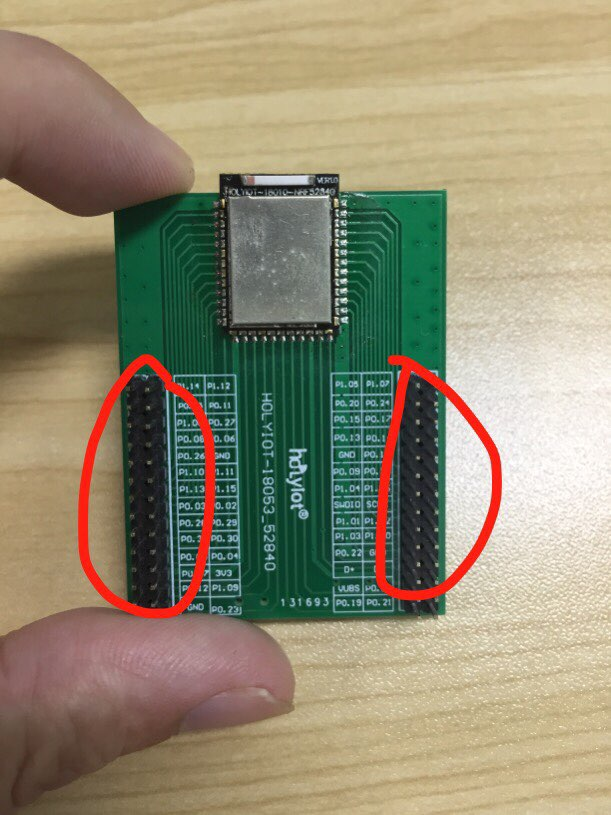
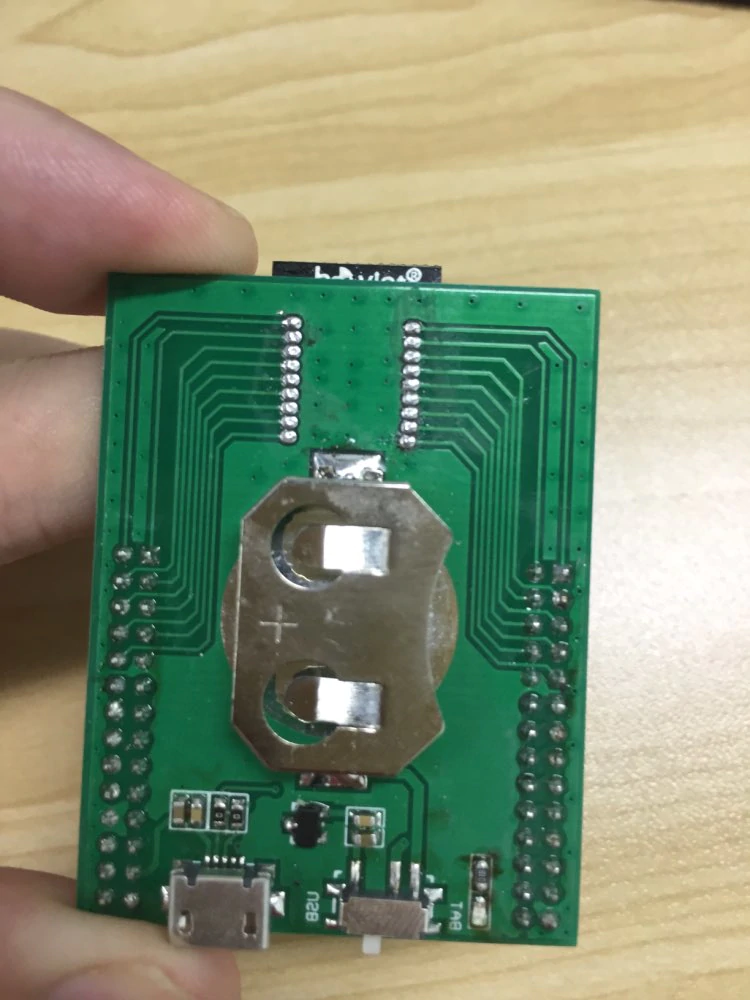
The question is, how far would be a reliable indoor distance which of course includes 3+ standard walls and how much difference is it compared to the nRF52832 (is the 840 really required)?
And is/will there be a full protocoll support for BLE5.0 (or at least 4.2) or any other protocol which is good enoght to not require an additonal radio like LoRa?
That would be great and very energy efficient for battery usage.At least it would solve my Flash/RAM problem for E-Paper (in comparison to the 328p) :-)
Looking forward to the progress of this device/thread. -
@neverdie I have ordered 10x nRF52832 and also 5x nRF52840. Two of theme are in the E73... modul which is not really easy to solder with it's additional pads in inner rows under the modul and the company has no plans to change it for private makers.
I have ordered 2 but it looks like they have discontinued that or working on an upgrade?
https://www.aliexpress.com/item/nRF52840-Bluetooth-5-0-240MHz-RF-Transceiver-CDSENET-E73-2G4M08S1C-8dbm-Ceramic-Antenna-BLE-4-2/32906661666.html?spm=a2g0s.9042311.0.0.50784c4dZJ6WSYI have seen the dongles but they are still quite expensive:
https://www.aliexpress.com/item/NRF52840-Dongle-Original/32890524949.html?spm=2114.search0104.3.1.dfe53098heRtmA&ws_ab_test=searchweb0_0,searchweb201602_5_10065_10068_10547_10059_10548_10696_100031_5017615_10084_10083_10103_5017516_451_10618_452_10304_10307_5017416_10820_10821_10302_5017715,searchweb201603_60,ppcSwitch_4&algo_expid=c3e31797-40ab-4a13-b99e-df32e618cf5c-0&algo_pvid=c3e31797-40ab-4a13-b99e-df32e618cf5c&transAbTest=ae803_2&priceBeautifyAB=0This modul is also makers friendly and around 10-11us$ (4 pieces for around 40us$)
https://www.aliexpress.com/item/New-product-NRF52840-Bluetooth-5-MESH-Bluetooth-low-power-module-ZIGBEE-GT840A01/32909273516.html?spm=2114.search0104.3.43.bf083dad4DLBft&ws_ab_test=searchweb0_0,searchweb201602_5_10065_10068_10547_10059_10548_10696_100031_5017615_10084_10083_10103_5017516_451_10618_452_10304_10307_5017416_10820_10821_10302_5017715,searchweb201603_60,ppcSwitch_4&algo_expid=2fb40cd9-604f-47a8-b9f1-61d13e35e3cd-6&algo_pvid=2fb40cd9-604f-47a8-b9f1-61d13e35e3cd&transAbTest=ae803_2&priceBeautifyAB=0

I have also odered 3 nRF52840 dev boards from holyiot for 6us$ (which is quite ok).


The question is, how far would be a reliable indoor distance which of course includes 3+ standard walls and how much difference is it compared to the nRF52832 (is the 840 really required)?
And is/will there be a full protocoll support for BLE5.0 (or at least 4.2) or any other protocol which is good enoght to not require an additonal radio like LoRa?
That would be great and very energy efficient for battery usage.At least it would solve my Flash/RAM problem for E-Paper (in comparison to the 328p) :-)
Looking forward to the progress of this device/thread.@heinzv Dongles cost just $10 each if you buy them through a regular Nordic retailer. I don't know where you live (I'm guessing Germany?), but if it's in Europe it should be easier to find a retailer who has them in stock. If you go to the Nordic dongle page and click buy, it will link you to a page with all the official online sellers. Easy.
If you are concerned about range, then I would give #1 priority to picking a module which has a good antenna. Period. Full Stop. Read that again if you have to. Chip antennas are nicely compact, but they kill your range. The Nordic dongles seem to have pretty good range, so I think they are a good deal for $10.
Nordic's answer to people who ask "what is the indoor range?" is basically, "buy it and try it yourself," because there are just too many variables to consider. So, $20 for two dongles, and you have your answer.
It's my subjective impression that the indoor range on the nRF52840 at 1mbps or 2mbps may be roughly equal to an amplified nRF52832, such as the Fanstel BT832X. However, the nRF52840 can do a slower speed at 250kbps (using 802.11.15) that the nRF52832 can't do, and that should be able to have very noticeably longer range. I'm not at all sure about the 125Kbps long range that's only available through Bluetooth. I'm sure it's longer range, but Bluetooth seems not easy to program. Maybe a solution to that will be when someone does the inevitable module that can be controlled with simple AT commands. Better yet would be a highly simplified API to bluetooth.
-
@heinzv yes, for the moment sandeep nrf5 core is not using latest softdevice (still s132). I don't remember about mbed (I imagine they use latest) but mysensors is not on mbed.
Sure, subghz is not comparable with 2.4ghz. Like NeverDie said, there are many variables. The dongle have nice range when plugged in computer, it can be different if soldered on a different custom pcb, or using different software etc. Another point, is 2.4ghz can be crowded, depends where you live (no problem I live in rural area) but living in appartment in big cities I can imagine it's less quiet (coexistence&placement of wifi routers, phones, range extender, ble, zigbee, proprietary modes, more&more devices, not synced, channels overlap->selectivity&blocking etc..). Lot of variables for the real range.That said I'm not surprised that NeverDie has fun playing with this dongle. it looks sexy (although I decided to stop using nrf5).
cool! keep the good work @NeverDie :+1: -
@heinzv yes, for the moment sandeep nrf5 core is not using latest softdevice (still s132). I don't remember about mbed (I imagine they use latest) but mysensors is not on mbed.
Sure, subghz is not comparable with 2.4ghz. Like NeverDie said, there are many variables. The dongle have nice range when plugged in computer, it can be different if soldered on a different custom pcb, or using different software etc. Another point, is 2.4ghz can be crowded, depends where you live (no problem I live in rural area) but living in appartment in big cities I can imagine it's less quiet (coexistence&placement of wifi routers, phones, range extender, ble, zigbee, proprietary modes, more&more devices, not synced, channels overlap->selectivity&blocking etc..). Lot of variables for the real range.That said I'm not surprised that NeverDie has fun playing with this dongle. it looks sexy (although I decided to stop using nrf5).
cool! keep the good work @NeverDie :+1: -
@heinzv yes, for the moment sandeep nrf5 core is not using latest softdevice (still s132). I don't remember about mbed (I imagine they use latest) but mysensors is not on mbed.
Sure, subghz is not comparable with 2.4ghz. Like NeverDie said, there are many variables. The dongle have nice range when plugged in computer, it can be different if soldered on a different custom pcb, or using different software etc. Another point, is 2.4ghz can be crowded, depends where you live (no problem I live in rural area) but living in appartment in big cities I can imagine it's less quiet (coexistence&placement of wifi routers, phones, range extender, ble, zigbee, proprietary modes, more&more devices, not synced, channels overlap->selectivity&blocking etc..). Lot of variables for the real range.That said I'm not surprised that NeverDie has fun playing with this dongle. it looks sexy (although I decided to stop using nrf5).
cool! keep the good work @NeverDie :+1:@scalz said in Everything nRF52840:
That said I'm not surprised that NeverDie has fun playing with this dongle. it looks sexy (although I decided to stop using nrf5).
So, what do you use now ? @_@ -
I don't want to pollute this topic with another brand, or making people think it's a bad choice. Nrf5 is a nice arduino "compatible" mcu.
That just depends (in my case especially) on the application you want to build, the features available in frameworks, BOM etc.
@NeverDie I gave you hint in another thread ;)
it's not arduino compatible (and imho not a loss :) , except that needs to port some C sensors libs ). Same for mysensors, not compatible (at least not yet, but still some hope). -
You can also improve range with data whitening, though I'm not sure by how much. To enable it, substitute this line into the above code examples:
NRF_RADIO->PCNF1 = 0x2040101; //Means: data whitening enbled, base address is 4 bytes long (possible range is 2 to 4) and max size of payload is 1,and 1 bytes of static length payloadThen the hardware handles it automatically.
-
@heinzv
ST electronics has the dongle for 17 euros including shipping in the Netherlands/Europe.It's slowly getting cheaper on Aliexpress too. $25 here:
https://www.aliexpress.com/item/nRF52840-Dongle-original-genuine/32922402227.html -
@neverdie I have ordered 10x nRF52832 and also 5x nRF52840. Two of theme are in the E73... modul which is not really easy to solder with it's additional pads in inner rows under the modul and the company has no plans to change it for private makers.
I have ordered 2 but it looks like they have discontinued that or working on an upgrade?
https://www.aliexpress.com/item/nRF52840-Bluetooth-5-0-240MHz-RF-Transceiver-CDSENET-E73-2G4M08S1C-8dbm-Ceramic-Antenna-BLE-4-2/32906661666.html?spm=a2g0s.9042311.0.0.50784c4dZJ6WSYI have seen the dongles but they are still quite expensive:
https://www.aliexpress.com/item/NRF52840-Dongle-Original/32890524949.html?spm=2114.search0104.3.1.dfe53098heRtmA&ws_ab_test=searchweb0_0,searchweb201602_5_10065_10068_10547_10059_10548_10696_100031_5017615_10084_10083_10103_5017516_451_10618_452_10304_10307_5017416_10820_10821_10302_5017715,searchweb201603_60,ppcSwitch_4&algo_expid=c3e31797-40ab-4a13-b99e-df32e618cf5c-0&algo_pvid=c3e31797-40ab-4a13-b99e-df32e618cf5c&transAbTest=ae803_2&priceBeautifyAB=0This modul is also makers friendly and around 10-11us$ (4 pieces for around 40us$)
https://www.aliexpress.com/item/New-product-NRF52840-Bluetooth-5-MESH-Bluetooth-low-power-module-ZIGBEE-GT840A01/32909273516.html?spm=2114.search0104.3.43.bf083dad4DLBft&ws_ab_test=searchweb0_0,searchweb201602_5_10065_10068_10547_10059_10548_10696_100031_5017615_10084_10083_10103_5017516_451_10618_452_10304_10307_5017416_10820_10821_10302_5017715,searchweb201603_60,ppcSwitch_4&algo_expid=2fb40cd9-604f-47a8-b9f1-61d13e35e3cd-6&algo_pvid=2fb40cd9-604f-47a8-b9f1-61d13e35e3cd&transAbTest=ae803_2&priceBeautifyAB=0

I have also odered 3 nRF52840 dev boards from holyiot for 6us$ (which is quite ok).


The question is, how far would be a reliable indoor distance which of course includes 3+ standard walls and how much difference is it compared to the nRF52832 (is the 840 really required)?
And is/will there be a full protocoll support for BLE5.0 (or at least 4.2) or any other protocol which is good enoght to not require an additonal radio like LoRa?
That would be great and very energy efficient for battery usage.At least it would solve my Flash/RAM problem for E-Paper (in comparison to the 328p) :-)
Looking forward to the progress of this device/thread.@heinzv said in Everything nRF52840:
The question is, how far would be a reliable indoor distance which of course includes 3+ standard walls and how much difference is it compared to the nRF52832 (is the 840 really required)?
I think the short answer is that yes, it should be able to get through 3+ standard walls. There is some directionality to these antennas, so that can be a factor. You may not succeed if you aim the trace antennas in opposite directions, for instance. Using an external omni antenna might make the setup easier.
I think some of the claimed range for the nRF52840 is from coding gains added to the 125Kbps datarate. Without doing a lot of work, you might have to use bluetooth long-range to get those ranges. Not sure though.
-
@heinzv yes, for the moment sandeep nrf5 core is not using latest softdevice (still s132). I don't remember about mbed (I imagine they use latest) but mysensors is not on mbed.
Sure, subghz is not comparable with 2.4ghz. Like NeverDie said, there are many variables. The dongle have nice range when plugged in computer, it can be different if soldered on a different custom pcb, or using different software etc. Another point, is 2.4ghz can be crowded, depends where you live (no problem I live in rural area) but living in appartment in big cities I can imagine it's less quiet (coexistence&placement of wifi routers, phones, range extender, ble, zigbee, proprietary modes, more&more devices, not synced, channels overlap->selectivity&blocking etc..). Lot of variables for the real range.That said I'm not surprised that NeverDie has fun playing with this dongle. it looks sexy (although I decided to stop using nrf5).
cool! keep the good work @NeverDie :+1:@scalz you stopped because of what reason? And you did not want to tell why and what you're now using? It might be worth for us to know!
So far I plan to use ESP32 for most projects and trying to use the ultra low power nRF52 for battery powered devices. For the RF ranges I need to find out what is best. BLE or LoRa with RFM95 are my favorites now.
In a pure ESP environment ESPnow is also very good (we have tested it sucssfully within a 120m2 flat).
I have no better ideas so other HW devices far, but I'm always open for better ideas.@NeverDie I'm not from Germany but from Austria :-) I'll do testing with the 15 modules I will get in the next 2 weeks. Regarding the indorr range: Of yourse I read all the statements also from Nordic. I thought you have already some practical experience.
In the battery wall sensors, I can only use a small sizes antenna and the gateway will have a better antenna.
So the typical distance in a flat is around 15m but through at least up to 3+ walls
Of course most todays flats/houses have many bluetooth and WLAN devices around.
But we need an appropriate mysensors radio/protocol library for the nRF52's. Any yes we can play around with lower data rates to extend the range based on the signal range and transmissison stability.Looking forward to your experience and inputs.
-
Here's a simple sketch I wrote for the nRF52840-DONGLE that turns on, one at a time, each of the 4 programmable LED's on the dongle:
#include "mbed.h" #define BITMASK_LED1 64 //pin P0.06 #define BITMASK_LED2R 256 //PIN P0.08 #define BITMASK_LED2G 512 //PIN P1.09 #define BITMASK_LED2B 4096 //PIN P0.12 int main() { NRF_P0->PIN_CNF[6]=0x701; //Configure pin P0.6 as an output pin with high-drive '0' and disconnect '1' NRF_P0->PIN_CNF[8]=0x701; //Configure pin P0.8 as an output pin with high-drive '0' and disconnect '1' NRF_P0->PIN_CNF[12]=0x701; //Configure pin P0.12 as an output pin with high-drive '0' and disconnect '1' NRF_P1->PIN_CNF[9]=0x701; //Configure pin P1.09 as an output pin with high-drive '0' and disconnect '1' NRF_P0->DIR=BITMASK_LED1|BITMASK_LED2R|BITMASK_LED2B; //Set LED's as output pins NRF_P1->DIR=BITMASK_LED2G; //set LED2G as an output pin. while (true) { NRF_P0->OUT=BITMASK_LED2R|BITMASK_LED2B; //turn-on LED1. Turn-ff LED2R and LED2B. NRF_P1->OUT=BITMASK_LED2G; //Turn off LED2G wait(0.5); //wait 500ms NRF_P0->OUT=BITMASK_LED1|BITMASK_LED2B; //turn on LED2R and turn off LED1 and LED2B wait(0.5); //wait 500ms NRF_P0->OUT=BITMASK_LED1|BITMASK_LED2R; //Turn on LED2B and turn off LED1 and LED2R. wait(0.5); //wait 500ms NRF_P0->OUT=BITMASK_LED1|BITMASK_LED2R|BITMASK_LED2B; //turn off LED1 and LED2R and LED2B. NRF_P1->OUT=0; //Turn on LED2G wait(0.5); //wait 500ms } }The dongle per se isn't supported by mbed, which is why I'm doing it purely as register manipulations. Therefore, the code is completely portable and would transfer to whatever toolchain that you're using. I guess I'll write some support functions to make doing this easier in the future.
-
Good news. I just noticed that Fanstel will have a couple of amplified nRF52840, called the nRF52840X or nRF52840XE. They just aren't yet in production with them. At least to me, this will likely make a big difference in my level of satisfaction. Judging from the datasheet, it will have both a PA and an LNA, so even just having it on the gateway would be a worthwhile improvement.
-
Good news. I just noticed that Fanstel will have a couple of amplified nRF52840, called the nRF52840X or nRF52840XE. They just aren't yet in production with them. At least to me, this will likely make a big difference in my level of satisfaction. Judging from the datasheet, it will have both a PA and an LNA, so even just having it on the gateway would be a worthwhile improvement.
@neverdie said in Everything nRF52840:
nRF52840XE
If BLE5 alone works sufficient, that would be great. Worst case, I will use the nRF52 with RFM95 for the battery devices and an ESP32 + RFM95 for the gateway.
The new PCB's we plan with ranseyer will cover all possible combination and provides the mySX connector.

